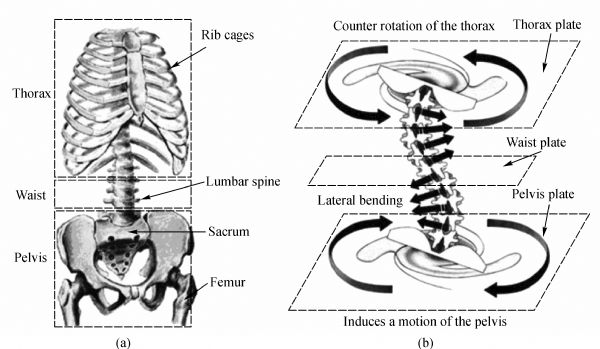

Frontiers of Mechanical Engineering >
An experimental characterization of human torso motion
Received date: 22 May 2015
Accepted date: 15 Jul 2015
Published date: 03 Dec 2015
Copyright
The torso plays an important role in the human-like operation of humanoids. In this paper, a method is proposed to analyze the behavior of the human torso by using inertial and magnetic sensing tools. Experiments are conducted to characterize the motion performance of the human torso during daily routine operations. Furthermore, the forces acting on the human body during these operations are evaluated to design and validate the performance of a humanoid robot.

Key words: experimental biomechanics; human torso; analysis; inertial sensor; characterization
Daniele CAFOLLA , I-Ming CHEN , Marco CECCARELLI . An experimental characterization of human torso motion[J]. Frontiers of Mechanical Engineering, 2015 , 10(4) : 311 -325 . DOI: 10.1007/s11465-015-0352-z
| 1 |
Hodgins J, Raibert M H. Biped gymnastics. International Journal of Robotics Research, 1990, 9(2): 115–128
|
| 2 |
Kavanagh J J, Morrison S, James D A,
|
| 3 |
Lee R Y W, Laprade J, Fung E H K. A real-time gyroscopic system for three-dimensional measurement of lumbar spine motion. Medical Engineering & Physics, 2003, 25(10): 817–824
|
| 4 |
Picerno P, Cereatti A, Cappozzo A. Joint kinematics estimate using wearable inertial and magnetic sensing modules. Gait & Posture, 2008, 28(4): 588–595
|
| 5 |
Roland L. Huston, Principle of Biomechanics. Boca Raton: CRC Press, 2009
|
| 6 |
Sims K. Evolving 3D morphology and behaviour by competition. Artificial Life, 1994, IV: 28–39
|
| 7 |
Virginia C. Bones and Muscles: An Illustrated Anatomy. New York: Wolf Fly Press, 1999
|
| 8 |
Zhu R, Zhou Z. A real-time articulated human motion tracking using tri-axis inertial/magnetic sensors package. IEEE Transactions on Neural Systems and Rehabilitation Engineering: A Publication of the IEEE Engineering in Medicine and Biology Society, 2004, 12(2): 295–302
|
| 9 |
Liang C, Ceccarelli M. Design and simulation of a waist-trunk system for a humanoid robot. Mechanism and Machine Theory, 2012, 53: 50–65
|
| 10 |
Coley B, Najafi B, Paraschiv-Ionescu A,
|
| 11 |
Henriksen M, Lund H, Moe-Nilssen R,
|
| 12 |
Hodgins J K. Biped gait transitions. In: Proceedings of the IEEE International Conference on Robotics and Automation. Sacramento: IEEE, 1991, 2092–2097
|
| 13 |
Bonato P. Wearable sensors/systems and their impact on biomedical engineering. IEEE Engineering in Medicine and Biology Magazine: The Quarterly Magazine of the Engineering in Medicine & Biology Society, 2003, 22(3): 18–20
|
| 14 |
Guo X L. Kay S L, Taher T. Unrestrained measurement of arm motion based on a wearable wireless sensor network. IEEE Transactions on Instrumentation and Measurement, 2010, 59(5): 1309–1317
|
| 15 |
Moe-Nilssen R, Helbostad J L. Interstride trunk acceleration variability but not step width variability can differentiate between fit and frail older adults. Gait & Posture, 2005, 21(2): 164–170
|
| 16 |
Ceccarelli M. Fundamentals of Mechanics of Robotic Manipulation. Amsterdam: Kluwer Academic Publishers, 2004
|
| 17 |
Meskers C G M, Fraterman H, van der Helm F C T,
|
| 18 |
Carbone G, Ceccarelli M. A procedure for experimental evaluation of Cartesian stiffness matrix of multibody robotic systems. In: 15th CISM-IFToMM Symposium on Robot Design, Dynamics and Control. Montreal, 2004, 1–9
|
| 19 |
Goodvin C, Park E J, Huang K,
|
| 20 |
Hall J S, Basic Biomechanics. 6th ed. Boston: McGraw-Hill, 2011
|
| 21 |
Roetenberg D, Luinge H J, Baten C T M,
|
| 22 |
InterSense
|
| 23 |
Kumar S. Trunk rotation: Ergonomic and evolutionary perspective. Theoretical Issues in Ergonomics Science, 2002, 3(3): 235–256
|
| 24 |
Vinciguerra A, Aulisa L, Ceccarelli M. Stability and the elastic behavior of the spine. Minerva Orthopaedic and Trauma, 1986, 37(11): 717–723 (in Italian)
|
/
| 〈 |
|
〉 |